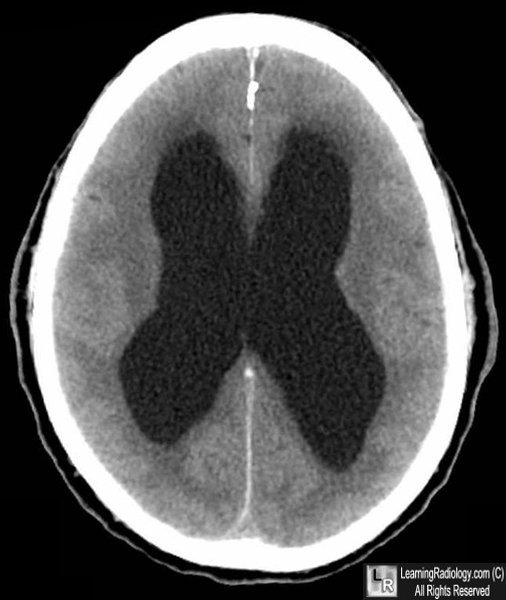|
|
Communicating Hydrocephalus
- Expansion of the ventricular system on the basis of an increase in the volume of cerebrospinal fluid contained within them
- May be due to
- Overproduction of cerebrospinal fluid (rare)
- Under-absorption of cerebrospinal fluid (at the level of the arachnoid villi)
- Obstruction of the outflow of cerebrospinal fluid from the ventricles
- In general, the ventricles are disproportionately dilated compared to the sulci in hydrocephalus, whereas both the ventricles and sulci are proportionately enlarged in atrophy
- The temporal horns are particularly sensitive to increases in CSF pressure
- The size of the temporal horns in hydrocephalus is greater than 2 mm
- In the absence of hydrocephalus, the temporal horns are barely visible
Obstructive Hydrocephalus
- Obstructive hydrocephalus is divided into two major categories: communicating (extraventricular obstruction) and non-communicating (intraventricular obstruction)
- Communicating hydrocephalus is due to abnormalities that inhibit the resorption of cerebrospinal fluid, most often at the level of the arachnoid villi
- CSF flow through the ventricles and over the convexities is unimpeded
- Reabsorption through the arachnoid villi can become obstructed by such things as subarachnoid hemorrhage and meningitis
- Classically, the 4th ventricle is dilated in communicating hydrocephalus and normal in size in non-communicating hydrocephalus
- Communicating hydrocephalus is usually treated with a ventricular shunt tube
- Non-communicating hydrocephalus occurs as result of tumors, cysts or other physically obstructing lesions that do not allow cerebrospinal fluid to exit from the ventricles

Communicating hydrocephalus. The ventricles are dilated but the sulci are not. The 4th ventricle (not shown) was also dilated.
|
|
|